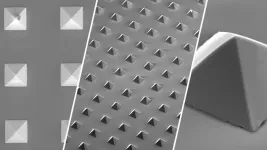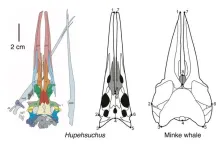(Press-News.org) NEW YORK, August 8, 2023 — CUNY ASRC researcher Adam Braunschweig’s lab is part of a newly awarded $20 million center from the U.S. National Science Foundation to understand the atomic-scale mysteries of "crushing" chemistry. The multi-institutional award will establish the Center for the Mechanical Control of Chemistry (CMCC), which will conduct work to understand how the mechanical application of force can enable new advances in chemistry and make industrial processes cheaper and more environmentally friendly.
“I’m excited that my lab is playing a part in research with the potential to transform the chemical manufacturing industry in a way that dramatically reduces the toxic waste that it generates,” said Braunschweig, who is a co-principal investigator on the NSF grant and a professor with the CUNY ASRC Nanoscience Initiative and Hunter College’s Chemistry and Biochemistry departments.
CMCC will be led by Texas A&M University with research and funding spread out over 10 institutions. Braunschweig’s lab will receive funding over the next five years to support a new post-doctoral researcher, two students and increased computational capacity. Additionally, the team will receive funding the build milling devices that carry out mechanochemical reactions.
Mechanical chemistry, or mechanochemistry, is the crushing of chemicals to produce reactions and substances. It has long been used by chemists and nature alike — for example, diamonds are created when carbon is squeezed under enormous pressure inside the Earth. While mechanical chemistry has been used to grind out everything from pigments in Renaissance-era paintings to medicinal compounds at your local pharmacy, the atomic-scale processes at the heart of such crushing transformations are not fully understood or predictable. Moreover, while heat or light are often used to impart the energy needed to make and break bonds in chemical reactions, the use of mechanical force to impart that energy and thus drive new types of chemistry remains an underexplored frontier.
"Using traditional chemical methods, chemists have discovered many effective ways to create substances that have enhanced human health and prosperity — like the ammonia essential for agricultural fertilizers, which help provide the world's food supply. But such substances could potentially be produced in a more sustainable way through undiscovered techniques of mechanical chemistry," says NSF Assistant Director for Mathematical and Physical Sciences Sean L. Jones. "NSF's Center for the Mechanical Control of Chemistry will focus on providing the insights necessary for innovative minds across America to scale it up."
The center itself is being scaled up. The $20 million from NSF is a phase two award from its Centers for Chemical Innovation program, which supports multiple centers aimed at solving fundamental challenges in chemical research and developing subsequent innovations. CMCC received a $2 million phase one award in 2020. The additional funding will enable the center to become a nexus for mechanical chemistry research across the U.S. by supporting work at 11 U.S. institutions in nine states.
The new funding will provide the center with instruments capable of investigating the effects of mechanical force at the atomic level, such as atomic force microscopes, electron microscopes, high-pressure diamond anvils and others. The center will help grow the scientific workforce through training and mentorship for early-career postdoctoral researchers, undergraduate and graduate students, and it will conduct educational outreach activities with local K-12 students and teachers.
For more information, visit NSF's Centers for Chemical Innovation program.
About the Advanced Science Research Center at the CUNY Graduate Center
The Advanced Science Research Center at the CUNY Graduate Center (CUNY ASRC) is a world-leading center of scientific excellence that elevates STEM inquiry and education at CUNY and beyond. The CUNY ASRC’s research initiatives span five distinctive, but broadly interconnected disciplines: nanoscience, photonics, neuroscience, structural biology, and environmental sciences. The center promotes a collaborative, interdisciplinary research culture where renowned and emerging scientists advance their discoveries using state-of-the-art equipment and cutting-edge core facilities.
END
'Crushing' chemical innovations at the heart of newly expanded NSF Center
Scientists to reveal the atomic-level workings inside the crushing and grinding of mechanical chemistry, with the potential to scale up their advances to make chemical manufacturing more sustainable and cost-effective.
2023-08-08
ELSE PRESS RELEASES FROM THIS DATE:
Bighorn sheep associations: understanding tradeoffs of sociality and implications for disease transmission
2023-08-08
Sociality plays a pivotal role in the lives of many animal species, influencing mating success, survival rates, and susceptibility to diseases. In the challenging environment of bighorn sheep populations, sociality is believed to have evolved for its fitness benefits. However, the delicate balance of costs and benefits associated with sociality can vary at different scales, leading to diverse interpretations of animal behavior.
New research titled "Bighorn sheep associations: understanding tradeoffs of sociality and implications for disease transmission" has been published in PeerJ Life & Environment. The study, ...
Lead poisoning from Ayurvedic medicines: rare but cautionary
2023-08-08
An article in CMAJ (Canadian Medical Association Journal) highlights a case of lead toxicity from Ayurvedic medicines in a young woman, and the complexity in diagnosing the rare condition https://www.cmaj.ca/lookup/doi/10.1503/cmaj.230592.
"Given that lead toxicity is uncommon and its presentation nonspecific, patients are often seen by many health care providers before the diagnosis is made," writes Dr. Julian Gitelman, Dalla Lana School of Public Health, University of Toronto, with coauthors. "A careful exposure history is essential to suggest the diagnosis."
The patient, a 39-year-old woman, visited the emergency department 3 times in 6 weeks ...
Holidaymakers be warned: Short, intense sun-seeking trips can disrupt skin’s microbiome
2023-08-08
Skin, the largest organ of the human body, is home to a vast array of bacteria, fungi, and viruses – microorganisms that compose the skin microbiota. Among other things, these microbial populations, which are organized in complex community structures, protect against pathogens.
Prolonged exposure to UVR is associated with damage to DNA in skin cells, inflammation, and premature skin aging, yet intentional sun-seeking behaviors remain common.
Due to a lack of studies focusing on how individual behavior influences UVR-associated microbiota shifts, and how this may relate to skin health, ...
New Antarctic extremes ‘virtually certain’ as world warms
2023-08-08
Extreme events in Antarctica such as ocean heatwaves and ice loss will almost certainly become more common and more severe, researchers say.
With drastic action now needed to limit global warming to the Paris Agreement target of 1.5°C, the scientists warn that recent extremes in Antarctica may be the tip of the iceberg.
The study reviews evidence of extreme events in Antarctica and the Southern Ocean, including weather, sea ice, ocean temperatures, glacier and ice shelf systems, and biodiversity on land and sea.
It concludes that Antarctica’s fragile environments “may well be subject to considerable stress and ...
Three-dimensional printing achieves precision light control for structural coloration
2023-08-08
The world's first 3D printing technology that can be used in transparent displays and AR devices has been developed, which implements the physical phenomenon of chameleon's changing skin color or peacock's beautiful feather color.
Dr. Jaeyeon Pyo’s team at KERI has succeeded in realizing a three-dimensional diffraction grating that can precisely control the path of light based on 'nanoscale 3D printing technology'. This is a novel technology that can utilize the principle of structural color observed in nature ...
Well-designed digital health platforms can improve the quality of life for people with Parkinson’s disease and their caregivers
2023-08-08
Philadelphia, August 8, 2023 – There is a need to better deliver information on medical nutrition therapy for patients with Parkinson’s disease (PD). Findings of a new study in the Journal of Nutrition Education and Behavior, published by Elsevier, show digital health serves as an additional health service resource, which increases the healthcare provider’s abilities to collect current visual and objective data, thereby decreasing patient and caregiver burden and medical expenses.
Lead author Dara Lyn LoBuono, PhD, RD, assistant professor in health and exercise science at Rowan ...
Bat activity lower at solar farm sites, study finds
2023-08-08
The activity level of six bat species was significantly reduced at solar farm sites, researchers have observed.
Their findings, published today in Journal of Applied Ecology, have the potential to impact and inform planning legislation and policy so that the benefits of solar power are reaped without impacting wildlife.
Renewable technologies are important in meeting energy demands sustainably. This is of vital importance given the roles of fossil fuels in producing carbon dioxide, a key driver of climate change. Renewable energy is growing at a rapid pace globally, with solar photovoltaic power ...
New model reduces bias and enhances trust in AI decision-making and knowledge organization
2023-08-08
University of Waterloo researchers have developed a new explainable artificial intelligence (AI) model to reduce bias and enhance trust and accuracy in machine learning-generated decision-making and knowledge organization.
Traditional machine learning models often yield biased results, favouring groups with large populations or being influenced by unknown factors, and take extensive effort to identify from instances containing patterns and sub-patterns coming from different classes or primary sources.
The medical field is one area where there are severe implications for biased machine learning results. Hospital staff and medical ...
Whale like filter-feeding discovered in prehistoric marine reptile
2023-08-08
A remarkable new fossil from China reveals for the first time that a group of reptiles were already using whale-like filter feeding 250 million years ago.
New research by a team from China and the UK has shown details of the skull of an early marine reptile called Hupehsuchus that indicate it had soft structures such as an expanding throat region to allow it to engulf great masses of water containing shrimp-like prey, and baleen whale-like structures to filter food items as it swam forward.
The team also found that the Hupehsuchus skulls show the same grooves and notches along the edges of its jaws similar to baleen whales, ...
New research shines light on how COVID-19 vaccination reduces severity and mortality after breakthrough infections
2023-08-08
In one of the largest studies of its kind, researchers provide answers to whether COVID-19 vaccinations reduce sickness and mortality following infection with SARS-CoV-2.
The study published today in The Lancet Microbe found among individuals recently infected with SARS-CoV-2, those who were fully vaccinated had lower concentrations of almost all inflammation markers (cytokines and chemokines) than those who were unvaccinated in the short-term and long-term after symptomatic SARS-CoV-2 infection.
While vaccinations don’t entirely prevent infection, this study demonstrates that vaccination significantly reduces morbidity and mortality by significantly reducing elevated levels ...
LAST 30 PRESS RELEASES:
Heart-brain connection: international study reveals the role of the vagus nerve in keeping the heart young
Researchers identify Rb1 as a predictive biomarker for a new therapeutic strategy in some breast cancers
Survey reveals ethical gaps slowing AI adoption in pediatric surgery
Stimulant ADHD medications work differently than thought
AI overestimates how smart people are, according to HSE economists
HSE researchers create genome-wide map of quadruplexes
Scientists boost cell "powerhouses" to burn more calories
Automatic label checking: The missing step in making reliable medical AI
Low daily alcohol intake linked to 50% heightened mouth cancer risk in India
American Meteorological Society announces Rick Spinrad as 2026 President-Elect
Biomass-based carbon capture spotlighted in newly released global climate webinar recording
Illuminating invisible nano pollutants: advanced bioimaging tracks the full journey of emerging nanoscale contaminants in living systems
How does age affect recovery from spinal cord injury?
Novel AI tool offers prognosis for patients with head and neck cancer
Fathers’ microplastic exposure tied to their children’s metabolic problems
Research validates laboratory model for studying high-grade serous ovarian cancer
SIR 2026 delivers transformative breakthroughs in minimally invasive medicine to improve patient care
Stem Cell Reports most downloaded papers of 2025 highlight the breadth and impact of stem cell research
Oxford-led study estimates NHS spends around 3% of its primary and secondary care budget on the health impacts of heat and cold in England
A researcher’s long quest leads to a smart composite breakthrough
Urban wild bees act as “microbial sensors” of city health.
New study finds where you live affects recovery after a hip fracture
Forecasting the impact of fully automated vehicle adoption on US road traffic injuries
Alcohol-related hospitalizations from 2016 to 2022
Semaglutide and hospitalizations in patients with obesity and established cardiovascular disease
Researchers ‘listen in’ to embryo-mother interactions during implantation using a culture system replicating the womb lining
How changing your diet could help save the world
How to make AI truly scalable and reliable for real-time traffic assignment?
Beyond fragmented markets: A new framework for efficient and stable ride-pooling
Can shape priors make road perception more reliable for autonomous driving?
[Press-News.org] 'Crushing' chemical innovations at the heart of newly expanded NSF CenterScientists to reveal the atomic-level workings inside the crushing and grinding of mechanical chemistry, with the potential to scale up their advances to make chemical manufacturing more sustainable and cost-effective.







